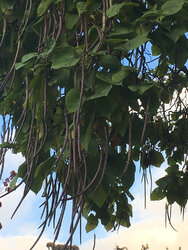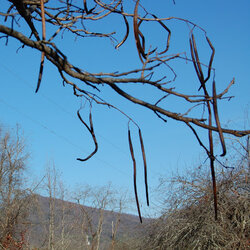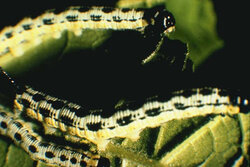Tree ID
- Thread starter saewoody
- Start date
-
Active since 1995, Hearth.com is THE place on the internet for free information and advice about wood stoves, pellet stoves and other energy saving equipment.
We strive to provide opinions, articles, discussions and history related to Hearth Products and in a more general sense, energy issues.
We promote the EFFICIENT, RESPONSIBLE, CLEAN and SAFE use of all fuels, whether renewable or fossil.
You are using an out of date browser. It may not display this or other websites correctly.
You should upgrade or use an alternative browser.
You should upgrade or use an alternative browser.
U.P.Boiler
Member
Tom123
Burning Hunk
I'm pretty sure that's a Catalpa tree.
Sent from my iPhone using Tapatalk
Sent from my iPhone using Tapatalk
+1 for Catalpa, pods are the give away.
After looking up Catalpa tree online, I believe you gentlemen are correct. Not sure I had seen one before, definitely haven't heard the name before. Thanks.
Sent from my iPhone using Tapatalk
CincyBurner
Minister of Fire
+1 on catalpa (Catalpa speciosa). Some people call it "cigar tree" because of the bean-shaped fruit (saewoody: You can see in crown of tree in your pic). Leaf pattern is whorled http://dendro.cnre.vt.edu/dendrology/syllabus/factsheet.cfm?ID=25
Catalpa wood is light and not much good for firewood, but I've been told that the catalpa hornworm caterpillar that frequently feed on its leaves makes for good fish (bass) bait. https://bygl.osu.edu/node/767
Catalpa wood is light and not much good for firewood, but I've been told that the catalpa hornworm caterpillar that frequently feed on its leaves makes for good fish (bass) bait. https://bygl.osu.edu/node/767
Rangerbait
Feeling the Heat
Black locus
Sent from my SM-G935V using Tapatalk
Haha
Vanilla bean tree - your RICH...or catalpa, which is pretty darn soft stuff (i.e. Not rich)
P.S. - just joking about the vanilla bean tree, so don 't go hitting up google and wasting your time.
P.S. - just joking about the vanilla bean tree, so don 't go hitting up google and wasting your time.

After looking up Catalpa tree online, I believe you gentlemen are correct. Not sure I had seen one before, definitely haven't heard the name before. Thanks.
Sent from my iPhone using Tapatalk
LOL that was an easy one for me, and I'm not good at tree ID. We used to live on a street named Catalpa, that was lined with Catalpa trees. Pods made a heck of a mess clogging the storm severs. Roots were invasive to if I recall correctly.
trguitar
Feeling the Heat
Soundchasm
Minister of Fire
On Dad's old property somebody had planted a grove of them ostensibly to help get rid of standing water.
Didn't really work all that well...
Didn't really work all that well...

Fuut Master
Member
armanidog
Minister of Fire
Dark slender pods, a foot or longer, hung from all the limbs of that tree better known as the catalpa.
Supposedly, the tree was a totem for the Catawba indians, and it was only due to a transcription error by a botanist that the name "Catalpa," rather than "Catawba" was applied to the tree. To my way of thinking, it’s one of those humble trees that doesn’t get its due respect. With a thick covering of heart-shaped leaves it provides a protected refuge for many species of birds.
If you want to catch catfish, remember this:
The tree is favored by the Catalpa Sphinx moth. The caterpillars of that moth eat the leaves of the catalpa, and are such an excellent live bait for fishing that some dedicated anglers maintain small groves of the trees, just to have a reliable source of "catawba-worms".
Indians smoked the catalpa seed pods for the hallucinogenic effect, which is why the tree became known as the "Indian Cigar Tree." I’d be more than happy to report on anyone else’s experience in this regard. I believe I’ll pass, but I do have a couple of pods for anyone who wants to give it a try.
Go ahead.
Light up.
Tune in. Turn on. Drop out.
http://gulahiyi.blogspot.com/2009/01/tripping-through-valley-of-green-bird.html
Bream, bass, etc love catawba worms. And the worms are tough, you can usually catch 2-3 fish with the same worm.
hickoryhoarder
Minister of Fire
Catalpa. The leaves have a distinct shape and can get very big. The combination of the fruit and leaf shape make it an easy one to remember.
fbelec
Minister of Fire
Similar threads
- Replies
- 12
- Views
- 791




